“The more money you have, the more vegetation you have and the less urban heat island you experience”, said Chris Martin, a landscape horticulturist and ecosystem stress plant physiologist, at an urban heat island panel discussion I attended yesterday in Tempe organized by ASU’s Sustainable Cities Network. Another panelist, Professor Harvey Bryan, a building technology expert with the ASU School of Sustainability, confirmed Martin’s sentiment saying, “wealthier communities are cooler than poorer ones.”
The fact that wealthier communities enjoy a cooler summertime temperatures than their poorer neighbors resonated deeply with me because I see it everyday in my own neighborhood.
Red Mountain, the new duplex we recently bought, renovated and moved into, is just outside of the Woodlea Historic Neighborhood, a neighborhood that is lush with old trees and irrigated lots with turf grass. Our duplex borders the southern edge of Woodlea, on Monterosa Street, a street that has been relegated to various sizes of multi-family units.
This google earth image illustrates my point:
See the A marker? That’s Red Mountain. See how north of Red Mountain is full of trees and green lots? That’s the Woodlea Historic Neighborhood. All of those homes are single-family houses, probably mostly owner-occupied.
Now on Monterosa, as I mentioned, every single building is a multi-family building, and you know what that means! Renters – people who can’t necessarily afford to buy a home, people who are probably poorer than those that own a home in the Woodlea Historic neighborhood.
Now Monterosa, the “renter’s street”, the street that I live on, is quite barren, is not irrigated, doesn’t have back yards, and has very few trees and other vegetation.
This is what it looks like:
And this is what a street in the Woodlea neighborhood north of us looks like:
Now you tell me which street experiences the urban heat island effect more? The one with a lovely canopy of trees and plenty of turf grass or the one that is made up of parking lots, pavement and ill-maintained rock or dirt yards?
Part of the reason Monterosa, the “renters street” has such little vegetation is because the owners of those buildings probably don’t live there. Heck, they probably don’t even live in this state. They figure, why invest in planting trees and maintain them when they don’t have to?
Me, being the owner and a resident here at Red Mountain, really feel the sting of this economic divide between the “renters street” and the predominantly owner-occupied single-family homes to the north of us, but that’s not the point. The point is, renters are people too! They deserve to enjoy the benefits of a lush urban forest!
Because of the density zoned on Monterosa, the city forgot about allowing enough space for vegetation that would mitigate urban heat island. In fact, when they subdivided this area, they cheated the multi-family buildings on the north side of Monterosa because they gave us no back yard! We back up right to the alley with a paved patio that is maybe 8 feet wide.
This is what it looks like, granted, the lush urban forest in the Woodlea neighborhood makes for a nice view of their backyards:
This is my view in to the south, from my front yard, the back side of an apartment building, it’s dumpster and its asphalt parking lot:
This is basically the extent of the vegetation in the multi-story apartment buildings on my street:
There’s got to be a better way! There’s got to be a way to achieve density in neighborhoods while not giving up all the cooling and other benefits of plentiful vegetation. Yes, vegetation requires space and density requires space, but we have to strike a balance in the regulatory building code to require more of the percentage of lots to be dedicated to open green space. Plus, the zoning strategy of clumping multi-families together, away from single-family areas, doesn’t work! A more integrated approach, where there is a mix of the two types of housing, would ensure that multi-family dwellers could benefit from the more open space of surrounding single family homes.
It’s not all bad on Monterosa Street. My neighbor, who also owns her duplex, has planted this wonderful oasis in her front yard, creating a cool island on our street:
And we are working with landsape designer Jeremy Stapleton to screen from the dismal view out of our front yard and to create our own little oasis on Monterosa, one that we hope will benefit our neighbors too…(I’ll keep you posted on our progress):
Professor Bryan said yesterday that the best way to mitigate urban heat island effect is through good planning and good design. It’s obvious that the residents of Monterosa Street were not in the front of city planners’ minds when they planned the area with dense multi-family buildings and no requirements for open green space. If you ask me, good design and good planning are even more important, not less, in dense multi-family zones than they are in single-family zones.
















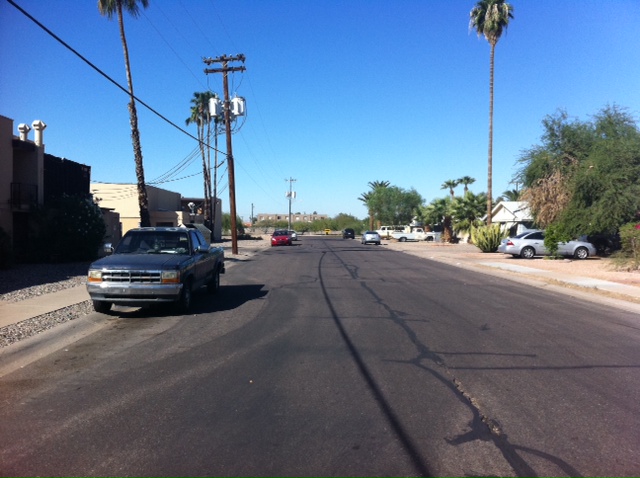
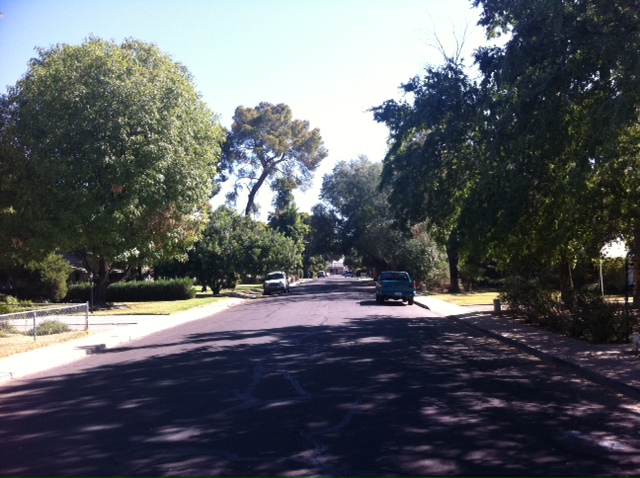
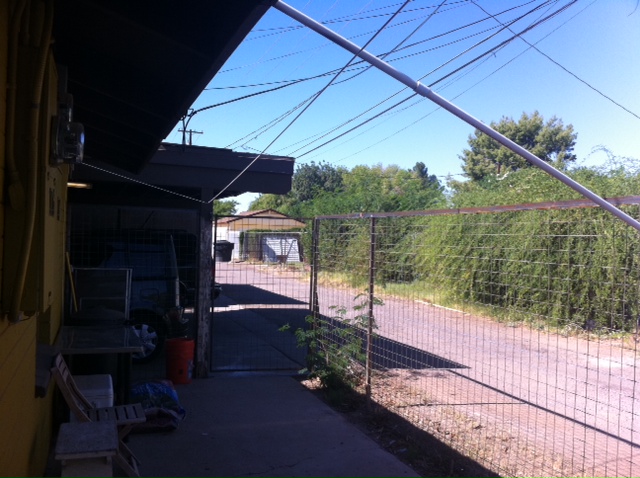

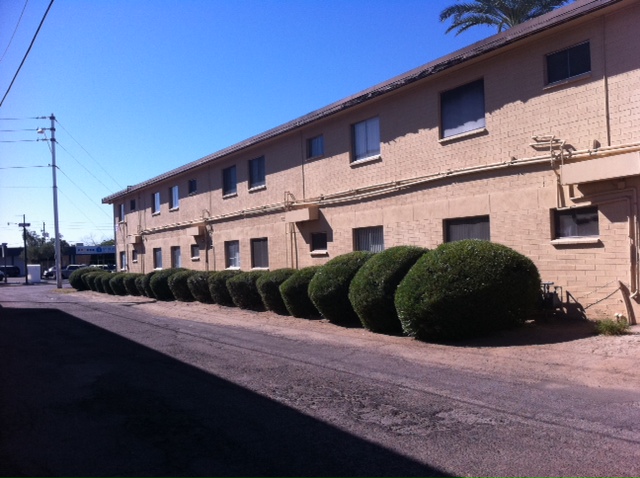
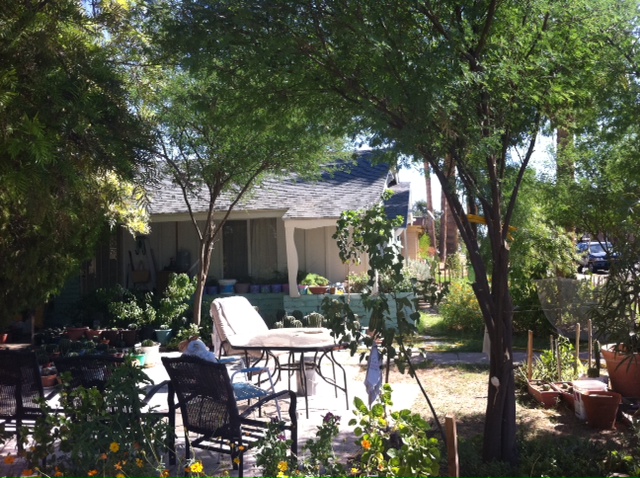
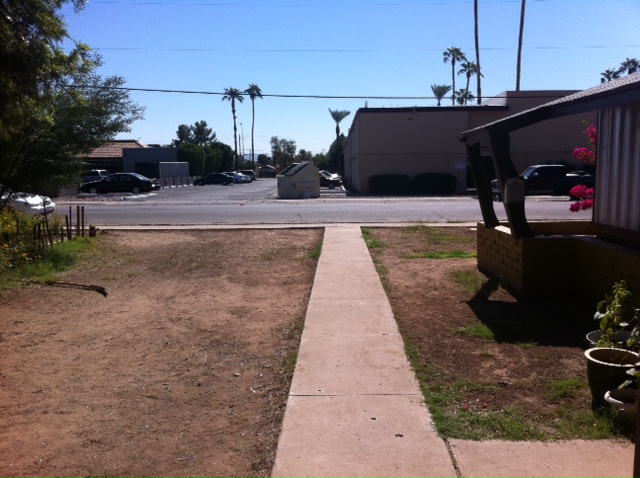




Hi Taz,
Your post implies that the City does not do any planting or maintenance of street trees — is that correct? If so, is that true throughout all of Phoenix? In San Francisco, some street trees are the responsibility of the the city, and others are the responsibility of homeowners. While the neighborhood differences are not always as stark as the ones you highlight here, it is there. The consequences are real.
Thanks for this thoughtful post.
As always a great thought provoking post. As a landlord I assure you that not all landlords have the “I don’t care about appearance approach”. Many of us do and that is the selling point for many landlords and the key to tenant retention. We have landscaped all our property with palms, lots of them. The canopy provides total shade in the summer and also traps the cooler air as it sinks below the canopy. The homes (walls and roofs) not heat up during the day. Palm can survive on minimal water, and with aloe planted as ground cover it is a total green look without the weekly mowing and heavy watering. Occasional trimming but at our choice when the bulk trash is due (saves on hauling costs) and the weather is nice. There are great deals to be made for multifamily rentals where the car cover is solar feeding the grid and cutting expense for the property owner.
Renting is an extremely viable way of living. With the mobility of career paths these days being rooted can sometimes be a disadvantage to a career. Many people also would rather call the landlord to have a repair taken care of then “deal with it” after a long day at work or have something interrupt a plan to perhaps take a weekend trip, or participate in activities in the city that may be more interesting than waiting for the A/C guy or entertaining bids on a Hot water heater replacement you know nothing about. Those of us in the business have our contacts and can get the job done on time and at minimal cost.
Anyone who has lived through this last bubble knows that homeownership can sometimes destroy your credit and cause problems. Don’t always buy the line that is sold to you.
I love my home and my projects, but then again I am a reincarnated Cambodian monk who worked on building Angkor Wat in the 12th Century……..
“Cheated” is a rather strong word. Last time I checked, people weren’t compelled to rent a property on Monterosa instead of going elsewhere. And if they’re looking for that added yard space, there are likely rental properties in the area that can provide it. Just not on Monterosa.
Shade trees and green lawns are certainly an amenity, but not an entitlement. Renters have the ability to make decisions based on trade-offs, and might prefer a lower-priced rental without greenery, or a green place over a non-green place for the same price in a similar location. If a landlord sees green shade as a advantage in attracting renters, they might just go on a planting spree (see that overgrown apartment complex on 7th Avenue, for instance). But then they’ve made somewhat of a commitment to keeping the place green & tidy (because the tenant in all likelihood won’t) – which could have an impact on the rental rates.
I’m not sure that changing the zoning code to require more “green space” will have the desired effect, especially if water becomes less cheap. Likely to see a few scraggly palo verdes and a lot of gravel.